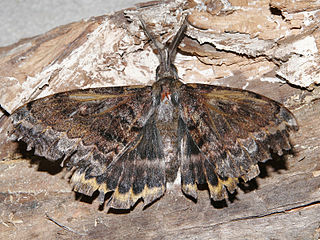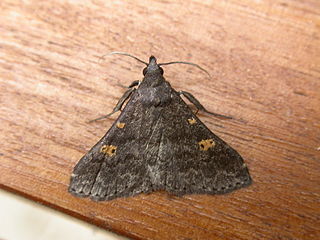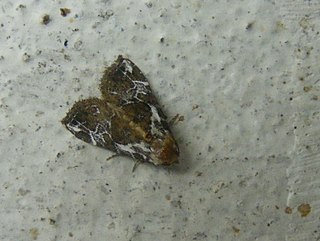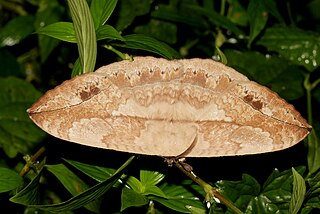
Macrolepidoptera is a group within the insect order Lepidoptera. Traditionally used for the larger butterflies and moths as opposed to the "microlepidoptera", this group is artificial. However, it seems that by moving some taxa about, a monophyletic macrolepidoptera can be easily achieved. The two superfamilies Geometroidea and Noctuoidea account for roughly one-quarter of all known Lepidoptera.

Bombycoidea is a superfamily of moths, including the silk moths, giant silk moths, sphinx moths, saturniids, and relatives. The superfamily Lasiocampoidea is a close relative and was historically sometimes merged in this group. After many years of debate and shifting taxonomies, the most recent classifications treat the superfamily as containing 10 constituent families.

Gelechioidea is the superfamily of moths that contains the case-bearers, twirler moths, and relatives, also simply called curved-horn moths or gelechioid moths. It is a large and poorly understood '"micromoth" superfamily, constituting one of the basal lineages of the Ditrysia.

Anthelidae is a family of Australian lappet moths in the order Lepidoptera. It had earlier been considered to be part of the Lasiocampoidea superfamily, but a 2008 molecular phylogenetic study, supported by a 2011 study, resulted in reincluding the Anthelidae in the superfamily Bombycoidea.

The Bombycidae are a family of moths known as silkworm moths. The best-known species is Bombyx mori (Linnaeus), or domestic silk moth, native to northern China and domesticated for millennia. Another well-known species is Bombyx mandarina, also native to Asia.

Carposinoidea, the "fruitworm moths", is a superfamily of insects in the lepidopteran order. The superfamily is also known as Copromorphoidea, which is a junior synonym. These moths are small to medium-sized and are broad-winged bearing some resemblance to the superfamilies Tortricoidea and Immoidea. The antennae are often "pectinate" especially in males, and many species of these well camouflaged moths bear raised tufts of scales on the wings and a specialised fringe of scales at the base of the hindwing sometimes in females only; there are a number of other structural characteristics. The position of this superfamily is not certain, but it has been placed in the natural group of "Apoditrysia" "Obtectomera", rather than with the superfamilies Alucitoidea or Epermenioidea within which it has sometimes previously been placed, on the grounds that shared larval and pupal characteristics of these groups have probably evolved independently. It has been suggested that the division into two families should be abandoned.

Apatelodidae, the American silkworm moths, is a family of insects in the order Lepidoptera. They are a family within the superfamily Bombycoidea, though they have in the past been considered a subfamily of Bombycidae.

The insect order Lepidoptera consists of moths and butterflies. Most moths are night-flying, while the butterflies are the mainly day-flying. Within Lepidoptera as a whole, the groups listed below before Glossata contain a few basal families accounting for less than 200 species; the bulk of Lepidoptera are in the Glossata. Similarly, within the Glossata, there are a few basal groups listed first, with the bulk of species in the Heteroneura. Basal groups within Heteroneura cannot be defined with as much confidence, as there are still some disputes concerning the proper relations among these groups. At the family level, however, most groups are well defined, and the families are commonly used by hobbyists and scientists alike.

Naarda is a large genus of erebid moths which currently encompasses 108 species. Initially identified by Francis Walker in 1866, it is in the family Erebidae. Somewhat ruddy in appearance, this genus is primarily distinguishable for its generally slender thorax and abdomen, and straight, porrect labial palpi. Most species are dark beige, but shading can reach a deep charcoal. Most species possess muddy yellow, reniform, orbicular stigmata featured on the forewings, which is reflected bilaterally superior on some species.

The Obtectomera is a clade of macro-moths and butterflies, comprising over 100,000 species in at least 12 superfamilies. This clade was initially defined by a pupal stage with the four anterior abdominal segments fused and immobile as the sole synapomorphy, but was later revised to include the modification of the dorsal edge of the pulvillus with a protrusion in the adult.

Anuga is a genus of moths of the family Euteliidae. The genus was erected by Achille Guenée in 1852.

Chorsia is a genus of moths of the family Erebidae. The genus was erected by Francis Walker in 1863.

Cossina is the name for both a section and subsection of Ditrysian insects in the order containing both butterflies and moths having a dorsal heart vessel. The section named Cossina contains two subsections: one also named Cossina having pupae with dorsal spines; and subsection Bombycina having spineless pupae.

Thyas honesta is a species of moth of the superfamily Noctuoidea and the family Erebidae first described by Jacob Hübner in 1824. It is found in the Indian subregion, Myanmar, Thailand, Peninsular Malaysia, Sumatra, Sri Lanka, Borneo and on the Philippines.

Lymantriini is a tribe of moths of the family Erebidae. This tribe is a group of polyphagous moths that reside mostly in the tropical regions of Afro-Eurasia but also North America.

Risoba is a genus of moths of the family Nolidae erected by Frederic Moore in 1881.

Eupterote is a genus of moths in the family Eupterotidae. It was first described by Jacob Hübner in 1820.
The Macroheterocera are a well supported clade of moths that are closely related to butterflies and macro-moths.
















